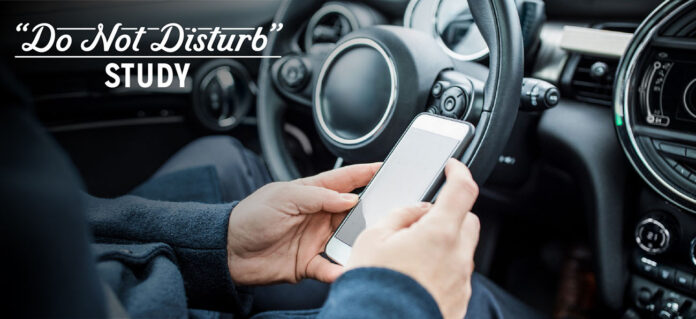 Nashville, TN – According to the National Highway Traffic Safety Administration (NHTSA), distracted driving contributes to approximately 9% of fatal crashes, although researchers believe that number is higher.
Nashville, TN – According to the National Highway Traffic Safety Administration (NHTSA), distracted driving contributes to approximately 9% of fatal crashes, although researchers believe that number is higher.
Despite texting bans in almost all 50 states, distraction remains a prevalent problem among drivers, especially younger generations. And yet smartphones themselves – a common form of distraction – may hold the key to curbing this risky behavior.
Today, most devices offer a “Do Not Disturb” feature designed to minimize distractions by silencing calls, messages, and notifications. Research from AAA indicates that when activated, this tool can effectively reduce smartphone interactions while driving.
Read the Full Report / Summary
“Although smartphones provide features to help curb distractions, many drivers simply do not use them,” said Megan Cooper, spokeswoman for AAA – The Auto Club Group. “Our goal was to understand why drivers hesitate to embrace these tools and explore ways to encourage their adoption. Doing so would contribute to better focus on the road and enhance overall traffic safety.”
Barriers to Adoption:
Researchers examined why drivers avoid using “Do Not Disturb” features and how to address their concerns:
- Misconceptions about functionality: Some drivers believe activating the feature will limit access to music and navigation, despite current technology allowing both functions to remain accessible. Other reasons include a lack of awareness about these settings or simply forgetting to turn them on.
- Fear of missing out (FOMO): Many people worry they’ll miss an important call or text when the feature is enabled, leading to hesitation in using it.
Despite these concerns, drivers expressed a preference for automatic activation in high-stress situations such as heavy rain, snow, or traffic—suggesting that they are more inclined to reduce distractions when greater focus is required.
Factors That Could Encourage Usage:
Drivers indicated that they would be more likely to use “Do Not Disturb” features if certain improvements were made, including:
- Better accuracy in detecting when a user is a passenger rather than a driver.
- Customizable controls over which apps are restricted.
- Potential insurance discounts for using the feature.
Generational Differences:
The study also found that younger drivers (ages 18–24), who are more prone to using their phones behind the wheel, tend to be more knowledgeable about “Do Not Disturb” settings than older generations. However, their confidence in using their phones safely while driving suggests they may not see the feature as necessary.
Research: 10-Week On-Road Study
To explore whether education and training could boost adoption, researchers conducted an on-road study with 18–24-year-old participants over a 10-week period. The first five weeks had no intervention, followed by five weeks using the “Do Not Disturb” feature.
During the transition, participants were surveyed about their understanding of the feature, then provided training on its usage. Importantly, the feature was set to activate automatically when driving was detected, and participants were instructed to keep the setting on throughout the remainder of the study.
The Results
Before training –
- 50% of participants did not know their phone had a “do not disturb” feature
- 85% reported not knowing how to use it
- 65% did not know it could be set to turn on automatically when driving was detected
After training –
- 100% of participants knew their phone had a “do not disturb” feature, knew how to use it, and that it could be set to turn on automatically
- 41% decrease in smartphone interactions
- 6% less likely to pick up their phone
- Opinions of “do not disturb” features remained unchanged
“We’ve all witnessed how smartphones can lead to distraction and risky driving, but it’s possible these devices could help us to prevent it,” said Jake Nelson, Director of Traffic Safety Advocacy & Research for AAA. “Increasing the use of Do Not Disturb technology requires more than building awareness. It requires behavior-focused strategies, smarter automation, consistent reinforcement through social norms, and possibly small incentives.”
AAA recommends the following to encourage the use of “do not disturb” features while driving:
- Increase awareness through targeted public education campaigns
- Integrate education of “do not disturb” features into driver training and licensing programs
- Improve automatic activation and situational awareness features (i.e., recognizing when the user is a passenger versus a driver)
- Use reminders and incentives to encourage drivers to use “do not disturb” features
- Address misconceptions through in-app messaging
- Leverage influencers to promote the use of this technology, especially to younger audiences
About The AAA Foundation for Traffic Safety
Established in 1947 by AAA, the Foundation for Traffic Safety is a nonprofit, publicly funded 501(c)(3) charitable research and educational organization. The AAA Foundation’s mission is to prevent traffic deaths and injuries by researching their causes and by educating the public about strategies to prevent crashes and reduce injuries when they do occur.
This research informs the development of educational materials for drivers, pedestrians, bicyclists, and other road users.



